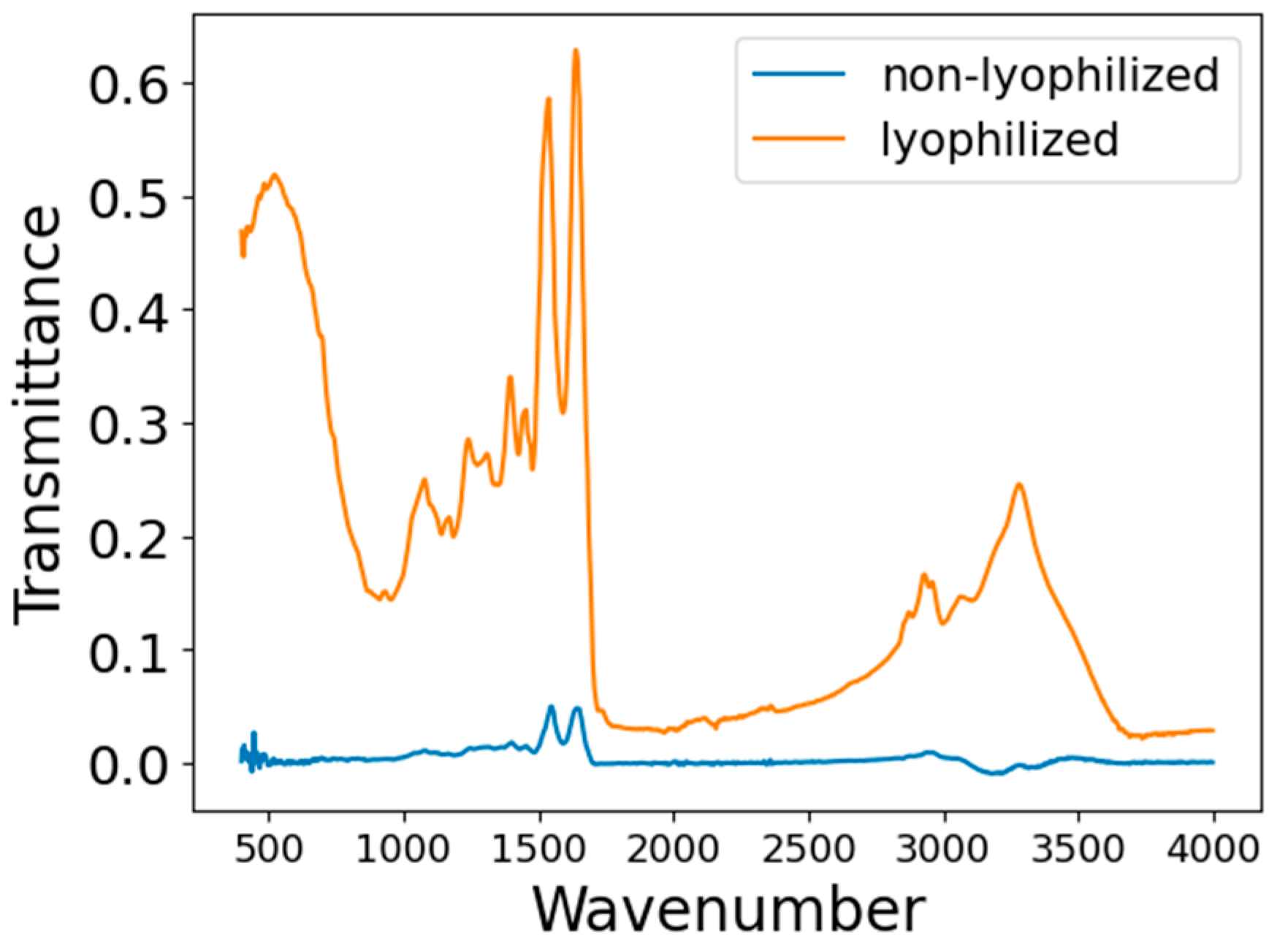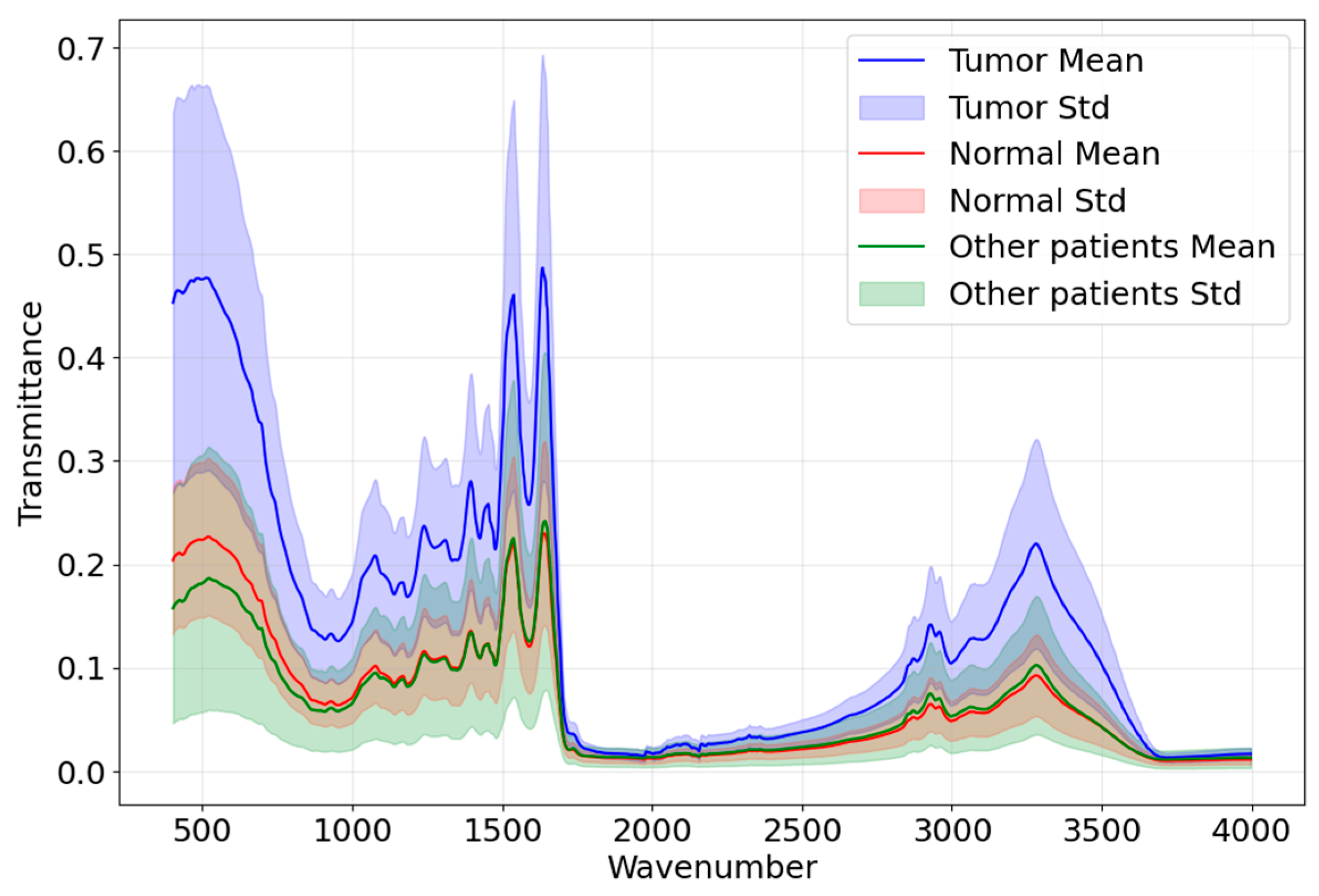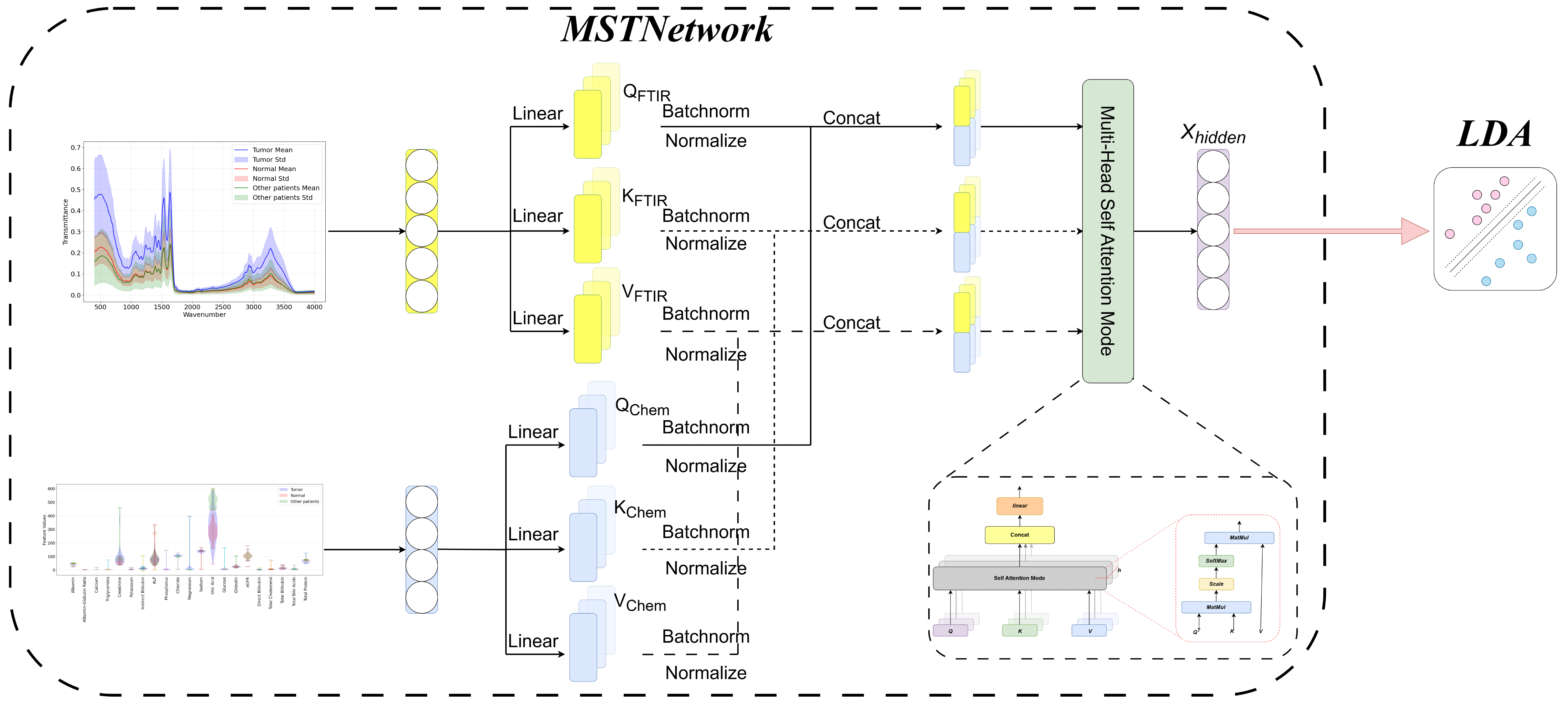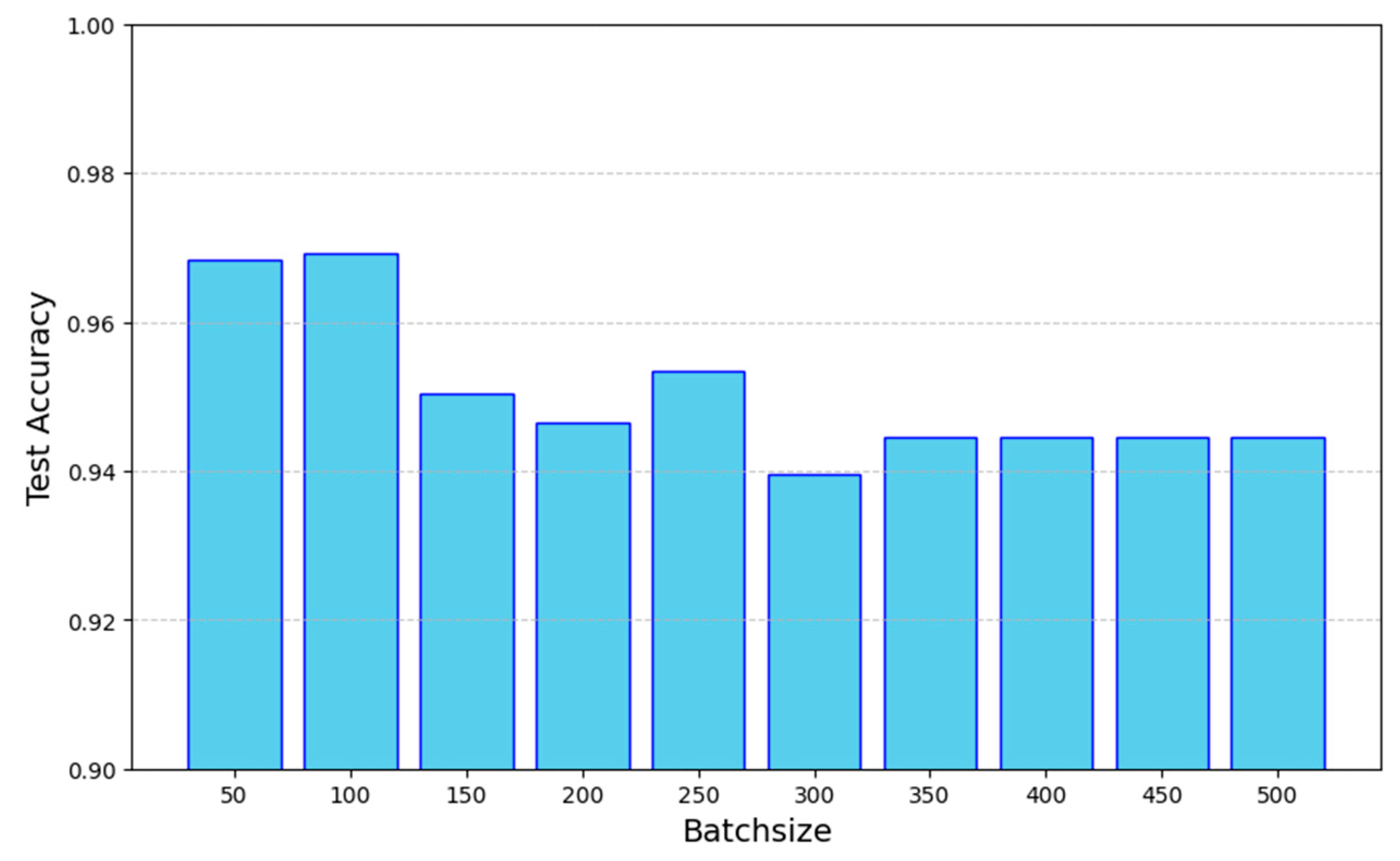AI-Assisted Detection for Early Screening of Acute Myeloid Leukemia Using Infrared Spectra and Clinical Biochemical Reports of Blood
Abstract
1. Introduction
2. Materials and Methods
2.1. Materials
2.2. Methods
2.2.1. Sample Processing
2.2.2. FTIR Spectroscopic Measurement
3. Algorithm
3.1. MSTNetwork
3.2. Contrastive Learning
4. Results
4.1. The Visualization of Contrastive Learning
4.2. The Selection of the Hyperparameter
4.3. Ablation Study
5. Conclusions
Author Contributions
Funding
Institutional Review Board Statement
Informed Consent Statement
Data Availability Statement
Conflicts of Interest
References
- Eigendorff, E.; Hochhaus, A. Acute leukemia in adults. Pathologe 2015, 36, 503–517. [Google Scholar] [PubMed]
- De Kouchkovsky, I.; Abdul-Hay, M. Acute myeloid leukemia: A comprehensive review and 2016 update. Blood Cancer J. 2016, 6, e441. [Google Scholar] [PubMed]
- Zimmermann, C.; Yuen, D.; Mischitelle, A.; Minden, M.D.; Brandwein, J.M.; Schimmer, A.; Gagliese, L.; Lo, C.; Rydall, A.; Rodin, G. Symptom burden and supportive care in patients with acute leukemia. Leuk. Res. 2013, 37, 731–736. [Google Scholar]
- Hockenberry, M.J.; Hooke, M.C.; Rodgers, C.; Taylor, O.; Koerner, K.M.; Mitby, P.; Moore, I.; Scheurer, M.E.; Pan, W. Symptom Trajectories in Children Receiving Treatment for Leukemia: A Latent Class Growth Analysis with Multitrajectory Modeling. J. Pain Symptom Manag. 2017, 54, 1–8. [Google Scholar]
- Hjalgrim, L.L.; Rostgaard, K.; Schmiegelow, K.; Soderhall, S.; Kolmannskog, S.; Vettenranta, K.; Kristinsson, J.; Clausen, N.; Melbye, M.; Hjalgrim, H.; et al. Age- and sex-specific incidence of childhood leukemia by immunophenotype in the Nordic countries. J. Natl. Cancer Inst. 2003, 95, 1539–1544. [Google Scholar] [PubMed]
- Zhu, W.; Liu, S.; Shi, Y.; Tang, Q.; Sun, J.; Bai, R.; Sun, Z.; Du, Z. The epidemic of acute lymphoid leukemia in China: Current trends and future prediction. Front. Oncol. 2023, 13, 1195065. [Google Scholar]
- Tucci, F.; Arico, M. Treatment of pediatric acute lymphoblastic leukemia. Haematologica 2008, 93, 1124–1128. [Google Scholar]
- Vrooman, L.M.; Silverman, L.B. Childhood acute lymphoblastic leukemia: Update on prognostic factors. Curr. Opin. Pediatr. 2009, 21, 1–8. [Google Scholar]
- Smith, M.; Arthur, D.; Camitta, B.; Carroll, A.J.; Crist, W.; Gaynon, P.; Gelber, R.; Heerema, N.; Korn, E.L.; Link, M.; et al. Uniform approach to risk classification and treatment assignment for children with acute lymphoblastic leukemia. J. Clin. Oncol. 1996, 14, 18–24. [Google Scholar]
- Cazzaniga, G.; Biondi, A. Molecular monitoring of childhood acute lymphoblastic leukemia using antigen receptor gene rearrangements and quantitative polymerase chain reaction technology. Haematologica 2005, 90, 382–390. [Google Scholar]
- Kuppenheimer, W.G.; Brown, R.T. Painful procedures in pediatric cancer—A comparison of interventions. Clin. Psychol. Rev. 2002, 22, 753–786. [Google Scholar] [PubMed]
- Braun, T.; Ehrlich, L.; Henrich, W.; Koeppel, S.; Lomako, I.; Schwabl, P.; Liebmann, B. Detection of Microplastic in Human Placenta and Meconium in a Clinical Setting. Pharmaceutics 2021, 13, 921. [Google Scholar] [CrossRef] [PubMed]
- Cooper, A.; Stokes, T.; Irwin, M.; Dixon, E.; Wilson, A.; Cefali, G. Determining aqueous deuterium detection limits via infrared spectroscopy to understand its capabilities for real-time monitoring of tritiated water. Fusion Eng. Des. 2024, 207, 114647. [Google Scholar]
- Fang, Y.H.; Qiao, Y.L.; Ye, H.; Shen, M.P. Airborne detection of urban environmental pollutants by FTIR system. In Optical Technologies for Atmospheric, Ocean, and Environmental Studies, Pts 1 and 2; SPIE Library: Bellingham, WA USA, 2005; Volume 5832, pp. 273–282. [Google Scholar]
- Ropodi, A.I.; Panagou, E.Z.; Nychas, G.E. Rapid detection of frozen-then-thawed minced beef using multispectral imaging and Fourier transform infrared spectroscopy. Meat Sci. 2018, 135, 142–147. [Google Scholar]
- Martin, F.L.; Kelly, J.G.; Llabjani, V.; Martin-Hirsch, P.L.; Patel, I.I.; Trevisan, J.; Fullwood, N.J.; Walsh, M.J. Distinguishing cell types or populations based on the computational analysis of their infrared spectra. Nat. Protoc. 2010, 5, 1748–1760. [Google Scholar]
- Ghimire, H.; Garlapati, C.; Janssen, E.A.M.; Krishnamurti, U.; Qin, G.S.; Aneja, R.; Perera, A.G.U. Protein Conformational Changes in Breast Cancer Sera Using Infrared Spectroscopic Analysis. Cancers 2020, 12, 1708. [Google Scholar] [CrossRef]
- Su, K.Y.; Lee, W.L. Fourier Transform Infrared Spectroscopy as a Cancer Screening and Diagnostic Tool: A Review and Prospects. Cancers 2020, 12, 115. [Google Scholar] [CrossRef]
- Ghimire, H.; Hu, X.J.; Qin, G.S.; Perera, A.G.U. Optimizing infrared spectral discrimination to enhance disease diagnostics: Monitoring the signatures of inflammatory bowel diseases with anti-TNFα therapy. Biomed. Opt. Express 2020, 11, 4679–4694. [Google Scholar]
- Ghimire, H.; Viennois, E.; Hu, X.J.; Qin, G.S.; Merlin, D.; Perera, A.G.U. Infrared spectrometric biomarkers for ulcerative colitis screening using human serum samples. J. Biophotonics 2022, 15, e202100307. [Google Scholar]
- Chaber, R.; Kowal, A.; Jakubczyk, P.; Arthur, C.; Lach, K.; Wojnarowska-Nowak, R.; Kusz, K.; Zawlik, I.; Paszek, S.; Cebulski, J. A Preliminary Study of FTIR Spectroscopy as a Potential Non-Invasive Screening Tool for Pediatric Precursor B Lymphoblastic Leukemia. Molecules 2021, 26, 1174. [Google Scholar] [CrossRef]
- Zelig, U.; Mordechai, S.; Shubinsky, G.; Sahu, R.K.; Huleihel, M.; Leibovitz, E.; Nathan, I.; Kapelushnik, J. Pre-screening and follow-up of childhood acute leukemia using biochemical infrared analysis of peripheral blood mononuclear cells. Biochim. Biophys. Acta-Gen. Subj. 2011, 1810, 827–835. [Google Scholar]
- Amin, Y.; Cecere, P.; Pomili, T.; Pompa, P.P. Smartphone-integrated YOLOv4-CNN Approach for Rapid and Accurate Point-of-Care Colorimetric Antioxidant Testing in Saliva. Prog. Electromagn. Res. 2024, 181, 9–19. [Google Scholar]
- Du, Y.; Hu, L.; Wu, G.H.; Tang, Y.S.; Cai, X.W.; Yin, L.F. Diagnoses in multiple types of cancer based on serum Raman spectroscopy combined with a convolutional neural network: Gastric cancer, colon cancer, rectal cancer, lung cancer. Spectrochim. Acta Part A-Mol. Biomol. Spectrosc. 2023, 298, 122743. [Google Scholar]
- Li, Z.; Li, Z.; Chen, Q.; Ramos, A.; Zhang, J.; Boudreaux, J.P.; Thiagarajan, R.; Bren-Mattison, Y.; Dunham, M.E.; McWhorter, A.J.; et al. Detection of pancreatic cancer by convolutional-neural-network-assisted spontaneous Raman spectroscopy with critical feature visualization. Neural Netw. 2021, 144, 455–464. [Google Scholar]
- Chen, C.; Chen, F.F.; Yang, B.; Zhang, K.; Lv, X.Y.; Chen, C. A novel diagnostic method: FT-IR, Raman and derivative spectroscopy fusion technology for the rapid diagnosis of renal cell carcinoma serum. Spectrochim. Acta Part A-Mol. Biomol. Spectrosc. 2022, 269, 120684. [Google Scholar]
- Leng, H.; Chen, C.; Chen, C.; Chen, F.; Du, Z.; Chen, J.; Yang, B.; Zuo, E.; Xiao, M.; Lv, X.; et al. Raman spectroscopy and FTIR spectroscopy fusion technology combined with deep learning: A novel cancer prediction method. Spectrochim. Acta A Mol. Biomol. Spectrosc. 2023, 285, 121839. [Google Scholar]
- Chang, M.; He, C.; Du, Y.; Qiu, Y.; Wang, L.; Chen, H. RaT: Raman Transformer for highly accurate melanoma detection with critical features visualization. Spectrochim. Acta A Mol. Biomol. Spectrosc. 2024, 305, 123475. [Google Scholar]
- Baratloo, A.; Hosseini, M.; Negida, A.; El Ashal, G. Part 1: Simple Definition and Calculation of Accuracy, Sensitivity and Specificity. Emergency 2015, 3, 48–49. [Google Scholar]








Disclaimer/Publisher’s Note: The statements, opinions and data contained in all publications are solely those of the individual author(s) and contributor(s) and not of MDPI and/or the editor(s). MDPI and/or the editor(s) disclaim responsibility for any injury to people or property resulting from any ideas, methods, instructions or products referred to in the content. |
© 2025 by the authors. Licensee MDPI, Basel, Switzerland. This article is an open access article distributed under the terms and conditions of the Creative Commons Attribution (CC BY) license (https://creativecommons.org/licenses/by/4.0/).
Share and Cite
Zhang, C.; Li, J.; Luo, W.; He, S. AI-Assisted Detection for Early Screening of Acute Myeloid Leukemia Using Infrared Spectra and Clinical Biochemical Reports of Blood. Bioengineering 2025, 12, 340. https://doi.org/10.3390/bioengineering12040340
Zhang C, Li J, Luo W, He S. AI-Assisted Detection for Early Screening of Acute Myeloid Leukemia Using Infrared Spectra and Clinical Biochemical Reports of Blood. Bioengineering. 2025; 12(4):340. https://doi.org/10.3390/bioengineering12040340
Chicago/Turabian StyleZhang, Chuan, Jialun Li, Wenda Luo, and Sailing He. 2025. "AI-Assisted Detection for Early Screening of Acute Myeloid Leukemia Using Infrared Spectra and Clinical Biochemical Reports of Blood" Bioengineering 12, no. 4: 340. https://doi.org/10.3390/bioengineering12040340
APA StyleZhang, C., Li, J., Luo, W., & He, S. (2025). AI-Assisted Detection for Early Screening of Acute Myeloid Leukemia Using Infrared Spectra and Clinical Biochemical Reports of Blood. Bioengineering, 12(4), 340. https://doi.org/10.3390/bioengineering12040340






